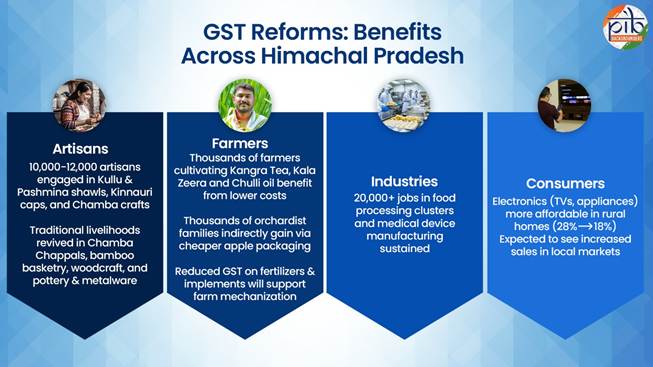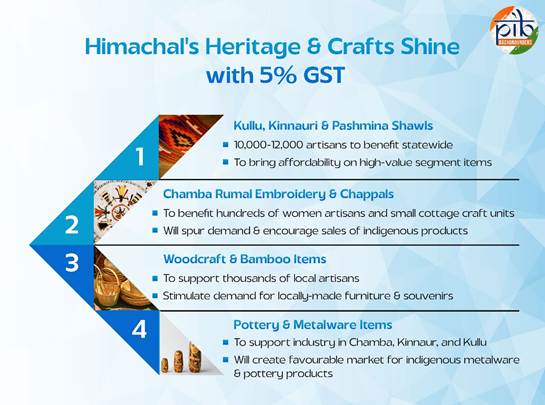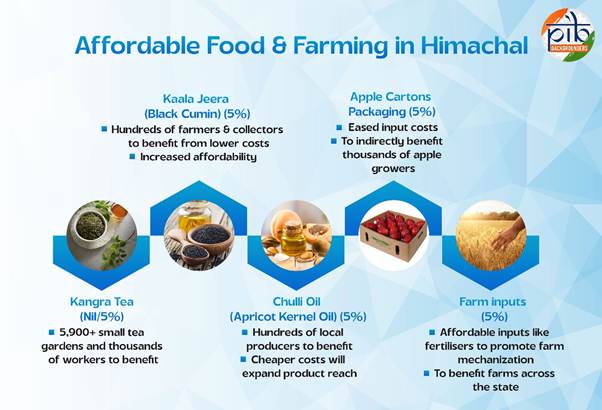PIB Headquarters
GST Reforms: Strengthening Himachal’s Heritage and Economy
Posted On:
01 OCT 2025 12:01PM by PIB Delhi
Key Takeaways
- 10,000-12,000 artisans benefit as GST on shawls, caps, and handicrafts drops from 12% to 5%
- 5,900 Kangra tea growers gain with loose tea now at 0% GST
- hundreds of farmers and rural households cultivating Kala Zeera and Chulli oil (5%)
- Nearly 20,000 workers in food processing (Baddi, Barotiwala and Nalagarh) and medical devices (Solan) benefit from GST cuts to 5%
|
Introduction
The latest GST reforms have eased burdens across the country, with varied benefits across states and sectors. In Himachal Pradesh, known for its rich traditional crafts, distinctive agricultural produce, and growing industries, recent GST rate cuts are set to make a strong impact.
They will bring relief for small artisans and weavers, new opportunities for farmers and cultivators, and greater competitiveness for industrial clusters in Himachal. Together, these reforms will strengthen livelihoods and position the state for sustained growth.

Shawls & Woollen Textiles
Himachal’s famed handloom products, especially its shawls and woollen textiles, are expected to gain relief under the new GST structure. These products are not just souvenirs; they are a livelihood for thousands of artisans.
In the Kullu valley, 3,000+ weavers involved in SHGs produce the brightly patterned, GI-tagged, Kullu shawls. These weavers are part of an estimated 10,000-12,000 handloom artisans statewide who derive their livelihood from these handicrafts. The neighbouring Kinnaur district’s shawls, adorned with intricate mythological motifs, are woven and hand-dyed by several thousand artisans. With GST reduced from 12% to 5%, the cost of these handwoven products is expected to fall for consumers. This move directly supports the artisans’ competitiveness and income.
Pashmina shawls also benefit from the revised rates from 12% to 5%. Though often associated with Kashmir, Himachal also has its own production in regions like Lahaul-Spiti, Kinnaur, Kullu, Mandi and Shimla. Many of the 10,000-12,000 artisans in handloom sector work with pashmina, crafting luxury wool crafts. The tax cut provides relief in this high-value segment too, potentially enabling artisans to price their shawls more competitively while maintaining margins.
Along with shawls, traditional Himachali caps, such as the multi-coloured Kinnauri caps and other woollen accessories like gloves also benefit with the revised GST slab. These items are hand-knitted by thousands of artisans across high-altitude districts. The lower tax is expected to modestly reduce prices for consumers. This will secure livelihoods for artisans and weavers and help in preserving generations-old crafts.
Handicrafts & Cottage Industries
Beyond textiles, Himachal Pradesh is home to a variety of handicrafts and cottage industries, all of which have benefited from GST rationalization. The GST on most handcrafted items was reduced from 12% to 5%; this has direct implications for artisans across the state.
Chamba Rumal Embroidery
The Chamba rumal is a GI-tagged, miniature hand-embroidered cloth, made primarily by women artisans in Chamba district. Several hundred women in localized clusters are involved in its production. With GST now 5%, the cost for buyers is lower, which could spur demand for these handkerchiefs. The tax cut also symbolizes recognition of the crafts’ cultural values and promotion of heritage art forms.
Chamba Chappals
Traditional leather slippers from Chamba, are another GI-tagged product, produced by hundreds of small cottage craft units. A lower GST will make their pricing more competitive against machine-made footwear and encourage sales of indigenous chappals. This will help artisans improve their margin.
Woodcraft items
From intricate wooden doors and panels to furniture, carved wooden products are produced in areas like Chamba, Kinnaur, and Kullu. This industry hires thousands of rural artisans in Himachal. The new GST rates put wooden articles in the 5% category which will stimulate demand for locally made wooden furniture and souvenirs. It will not only make these items more affordable but also support local artisans.
Pottery & Metalware
Himachal has a strong traditional metal craft industry with hundreds of small artisan units in the state engaged in these crafts. Spread across various districts, skilled artisans produce ritual vessels and jewellery and pottery. The revised GST rates of 5% are expected to create a more favourable market for indigenous metalware & pottery products. This will give artisans a better chance to sell their metal wares and pottery items.
Bamboo Items
Certain parts of Himachal produce bamboo products such as baskets, and other eco-friendly crafts. The industry employs hundreds of artisans, many coming from marginalised communities. These products, which were taxed 12%, now fall under 5%.
For the artisans, this is a welcome change, as it not only lowers prices for their customers but also highlights the government’s support for sustainable, traditional crafts.

Agriculture, Horticulture & Allied Growth Engines
Agriculture supports Himachal’s economy with several region-specific products that provide livelihood to hundreds of people. The GST reforms have extended significant benefits to this sector that not only brings affordability but also increased income for farmers and workers.
Kangra Tea
Kangra is known as the “Tea Capital of North India” for its lush tea gardens in Palampur and surrounding areas. Nearly 5,900 small tea gardens cultivate tea in Kangra with plantations and factories employing thousands of workers. This famed tea carrying a GI tag, is now GST exempted, with loose tea now attracting 0% GST. The new GST rates have effectively made loose tea leaves cheaper for buyers. This will boost sales of Kangra tea in competitive markets. Thus, government support through tax relief will not only bring affordability for households but also help in reviving traditional agricultural sectors.
Kala Zeera (Black Cumin)
Kala zeera is an aromatic spice (black cumin seed) grown in the high-altitude districts of Himachal Pradesh. This spice, known for its distinctive aroma and medicinal properties, is cultivated by a few hundred farmers and collectors in the region. The reduction in GST from 12% to 5% will likely lower the price of product, resulting in higher demand. Farmers will see increased orders for their produce, and it could encourage expanded cultivation.
Chulli Oil (Apricot Kernel Oil)
Chulli tel, a traditional apricot kernel oil, extracted in the Himalayan belt, is known for its therapeutic properties. With GST down to 5%, consumers outside the region may also find it a bit cheaper, potentially expanding the reach of this product. Overall, it’s a supportive step for a local industry that employs hundreds of rural producers.
Apple Cartons Packaging
Apples constitute around 80% of Himachal’s horticultural output. Grown across Shimla and other apple belts, this industry impacts thousands of apple growers. These growers rely on cartons, trays and other packaging materials to send their produce to markets across India. A reduction of GST to 5% on such materials is expected to ease input costs meaning cheaper boxes, directly benefiting the growers and other local packaging supply units.
Farming Inputs
The GST reforms have reduced rates of agricultural inputs like fertilizers to 5%. This will promote farm mechanization improving farming efficiency and output. Hence, the revised rates on inputs prices will benefit hundreds of thousands of farms across the state.

Industrial and Manufacturing Sector
Food Processing
Himachal’s food processing industry in Baddi, Barotiwala and Nalagarh will benefit from the reduced GST rates to 5% on variety of processed foods. For its industrial sector, this is significant because these processing units employ nearly 10,000 people in the region. Lower taxes on food items would likely reduce retail prices which will increase demand and boost sales volumes.
Medical Devices
Himachal’s medical industry in Solan district provides direct and indirect employment to around 10,000 people in the region. With many medical devices and apparatus now being taxed at 5%, this will significantly favour this industry.
Other Consumer Goods
Apart from specific industries and producer-centric changes, the GST reforms also bring relief to the average Himachali consumer. One notable change has been the reduction of GST on various consumer electronics and appliances from 28% to 18%, which directly affects rural households in Himachal. Lower prices on consumer goods are expected to spur demand in rural markets. This means local retailers in small towns will see more sales volume. Essentially, the GST cuts on electronics will make modern conveniences a bit more affordable.
Conclusion
The impact of GST rate cuts will be seen in the positive growth and socio-economic welfare of Indian economy. In Himachal’s case, these reforms will ensure that the Dev Bhoomi also becomes a land of thriving markets and flourishing livelihoods. The state’s unique products will gain, whether it is a weaver in Kullu, an apple farmer in Shimla, a tea grower in Kangra Valley, or a factory worker in Baddi, collectively propelling Himachal’s economy towards increased competitiveness and opportunity.
Sources:
Govt. of Himachal Pradesh:
https://hpkangra.nic.in/gallery/kangra-tea-garden/
World Bank:
https://www.worldbank.org/en/news/feature/2024/12/05/boosting-apple-cultivation-in-himachal-pradesh
Click here to see PDF
SK/M
(Release ID: 2173492)
Visitor Counter : 395